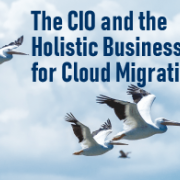 CIOs and their teams must make sure the business case for cloud migration is aligned with key business priorities, and that their migration plan addresses a few fundamental key success factors. In this Advisor, I offer a few thoughts based on my experience of making the case to migrate business applications and services to the cloud. I will leave other specific cloud opportunities, such as security or network services, for future conversations.
CIOs and their teams must make sure the business case for cloud migration is aligned with key business priorities, and that their migration plan addresses a few fundamental key success factors. In this Advisor, I offer a few thoughts based on my experience of making the case to migrate business applications and services to the cloud. I will leave other specific cloud opportunities, such as security or network services, for future conversations.
Cloud migration is often a multipronged effort across the dimensions of Internet as a service (IaaS), platform as a service (PaaS), and software as a service (SaaS) — with business drivers that are both specific and interdependent. A traditional driver for adoption of IaaS cloud-hosting infrastructure is cost — an argument that still resonates with most stakeholders. Cloud migration results in operational cost savings in companies where capabilities are spread across several environments because of a decentralized business strategy or intensive M&A activities. In those cases, cloud adoption becomes an efficient shortcut to consolidation of data centers, providing a tangible, positive impact to the bottom line. However, for many companies that have already consolidated their data processing assets into fewer facilities, often simultaneously implementing storage and server virtualization, operational cost benefits are likely to be minimal.
That was my experience with a consolidated environment where more than 80% of data processing capacity was run out of two global, redundant data centers with extensive use of virtualization (60% of 3,200 servers were virtual using VMWare). The key argument I used for cloud adoption was cost avoidance, which resulted from the closure of one of the two facilities — thus saving capital investment for renovations/upgrades and future growth. I also considered additional cost savings arising from using cloud infrastructure as a way of automating IT operations, which fit well with an ongoing initiative we had engaged in to automate processes in the I/O area. One key decision was to include a “sunset strategy” for legacy applications that were not suitable for cloud migration at a reasonable cost.
While it is possible to make a case for cloud migration based purely on IT cost savings, using the cloud as an enabler for quick delivery of business initiatives gives a much more compelling story. Today, both PaaS and SaaS are far more effective and faster routes to deliver new capabilities versus the traditional development and implementation of software on premises. Cloud allows for shorter delivery cycles and earlier delivery of business benefits.
The CIO must make that link consistent across projects, comparing the overall scenario of execution through the cloud versus traditional infrastructure, and support the investment in tools and processes. Above all, CIOs must plan for the multi-cloud environment that is likely to result from PaaS and SaaS adoption.
I have been involved in two major initiatives that have relied on cloud for delivery: the deployment of a PaaS/SaaS integrated HR system platform to support the implementation of an HR global shared service; and an Agile analytics program to deploy a cloud-based data lake platform, which combined structured and unstructured data to deliver use cases with Agile sprints. Both initiatives relied heavily on cloud environments from different vendors.
By highlighting how the cloud contributed to business benefits, we were able to include in each project contributions to the funding needed for talent, skills, processes, and tools to effectively and efficiently manage a multi-cloud environment (those include, among others, integration with ITSM environment, enhanced network and cloud security, as well as API-based integration platforms). Finally, while using a multi-cloud approach, we also identified a strategic cloud provider for any compatible business application.
For all CIOs, cloud migration is not a matter of “if,” but rather of “when” and “how.” The increasing performance of IaaS and PaaS offerings, as well the dynamic nature of cloud-native SaaS solutions, make cloud the default environment for enterprise application capabilities of the future. By combining various cloud initiatives into a holistic program, the CIO has a unique opportunity to tell a compelling story on enterprise cloud migration, while gaining stakeholder support for the required investment. Failing to do so will leave the IT function dealing with the complexity of a growing multi-cloud environment — playing catch-up as opposed to leading the conversation.
[This article appears compliments of its author, Vittorio Cretella, former Global CTO and Global CIO with Mars, Inc.]




